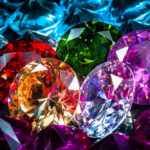Short answer: What’s a gem?
A gem is a precious or semi-precious stone that has been cut, polished and often used in jewelry. Some well-known examples of gems include diamonds, rubies, sapphires and emeralds. Gems are also valued for their rarity and beauty, and have been used in many cultures throughout history for decorative and symbolic purposes.
Understanding the properties of gems: A step-by-step guide
Gemstones are some of the most precious and stunning materials on earth. They have been used since time immemorial not only for their aesthetic value but also for their metaphysical properties. However, beyond the allure and mystique that surrounds gems, there is a lot to learn about them regarding their physical and chemical properties. In this step-by-step guide, we will demystify everything you should know about gemstones.
Step 1: Understand the anatomy of a gemstone
The first thing to do when learning about anything is to understand its constituent parts. A typical gemstone has three main parts; these are:
i) The crown – This refers to the top part of a stone where it comes into contact with light.
ii) Girdle – This section denotes the waistline or thinnest point in a gemstone.
iii) Pavilion – Refers to the bottom part of a stone.
Some stones such as pearls do not have all three sections present in them.
Step 2: Observe color and hue spectrum
The visual appeal of a gemstone is often an important factor while valuing it. Color hues are used to describe different shades from which one can get an idea of how valuable it is – blue sapphires coming along with star formation being super valuable compared to green ones for example.
However, some stones like diamonds don’t usually exhibit definite color hues but rather reflect white light – which could be clear or included in appearance due to internal imperfections called blemishes simultaneously creating interference patterns known as ‘fire’.
Step 3: Determine clarity through loupe observation
When buying any type of jewelry especially if priced high, examining its clarity becomes imperative as even minor visible flaws might reduce its value significantly unlike tiny imperfections in lower-priced gems like turquoise which may enhance the beauty.
A jeweler’s loupe magnifies small stones providing higher resolution images allowing observing cracks, bubbles, chips, or even detachments impact the stone’s value.
Step 4: Analyze cut and carat weight
Understanding a gemstones’ carat weight – its measurement unit – is imperative while discerning its true worth. In layman’s word, one carat weighs around 0.2 grams.
The cut has the power to influence how much light reflects off of it thus determining value, with better cuts yielding expensive work as they require utmost precision in creating angles and symmetry.
Step 5: Explore type-specific gemstone properties
Gemstones have provided several diverse applications outside their aesthetic uses such as medicinal, religious purposes among others without forgetting their scientific significance:
– Garnet for example is believed to promote healing and meditation.
– Amethyst supports peace of mind or sleep.
– Turquoise is linked with protection against evil powers and illness prevention from negative jolts.
– Pearls are capable of resisting extreme heat and UV light due to specific chemical formations in them.
In conclusion, understanding gemstones isn’t just recognizing their value but appreciating their unique aura alongside metaphysical aspects. For whichever reason compels you to learn more about any number of gemstones on earth taking notice that there’s more than meets the eye.
What’s a gem? Your top FAQs answered
Gems are the epitome of timeless beauty and elegance. From diamonds to emeralds, sapphires to rubies, these precious stones have captivated human imagination since ancient times. But what exactly is a gemstone, how are they formed and where can you find them? Here we answer some of your top FAQs about gems.
What is a gemstone?
Gemstones are minerals or organic materials that have been cut & shaped for use in jewelry or other decorative objects. They can be found in various regions around the world such as South America, Africa and Asia.
How are gemstones formed?
Most gemstones form deep within the earth under intense heat and pressure. This process takes millions of years to occur and results in minerals taking specific crystalline forms which make them suitable for jewellery making purposes.
What gives certain gemstones their unique color?
The colors of gems vary based on the elements they contain as well as factors such as light sources or impurities within the crystal itself. For instance, iron creates green hues; chromium results in pink or red while cobalt produces blue colors in stones.
What makes one type of gemstone more valuable than another?
Gems are valued based on their rarity, demand among consumers & market supply. Some types of stones have become iconic over time like diamonds which received value from proper branding by De Beers company; others gain higher worth due to their perceived healing properties such as Amethysts and Opals
Are all gemstones durable enough for everyday wear?
No! Some require extra care if they’re going to last long amidst regular usage- emeralds being one example: A brittle but popular jewel known best for providing an exceptional green colour-tinge.
Other gems like diamonds, sapphire’s and rubies may better resist scratches due to its hardness properties making them the perfect choice for everyday wear.
Where can I buy legitimate & high-quality gems?
It depends on what type of gem you want to purchase since there are many places that offer unique variations of these jewels; here is a list of some popular options:
– Jewellery Stores (both online & physical)
– Gemstone fairs or exhibitions – organized by reputed industry leaders within the field and they often come with certificates of authenticity on purchase.
– From respected gemstone dealers – who are responsible for sourcing different types of gems worldwide.
In conclusion, the beauty and elegance displayed by precious gems know no bounds. Though they differ in origin, formation process or value among other things; to many, acquiring them can feel like an irresistible allure: Perhaps because it’s their lustre or perceived healing properties- whatever the reason, wearing them makes you feel special too. Use this FAQ guide as a starting point for your own research and soon enough you might just be on the way to owning your very own sparkly treasure.
Top 5 surprising facts about precious stones
Precious stones have fascinated humans for centuries. With their stunning colors, unique properties and high value, these gems have been sought after and adorned by royalty, celebrities, and the everyday jewelry lover alike. However, there are some surprising facts about precious stones that most people are not aware of. Here are the top 5 that will make you see them in a new light.
1. Diamonds Are Not Actually Rare:
Diamonds have been marketed as rare gems for decades, but the truth is that they are actually not all that rare. In fact, diamonds are found in many places around the world including Canada and Russia. The reason why diamonds are so valuable is not because they are scarce but rather because of controlled production by major companies like De Beers.
2. Rubies and Sapphires Contain the Same Mineral:
Rubies and sapphires may be known for their distinct colors (red for rubies and blue for sapphires), but they both contain the same mineral called corundum which gives them their hardness and durability. The only thing that differentiates rubies from sapphires is how much chromium is present in each gem – more chromium produces red rubies while less produces blue sapphires.
3. Opals Aren’t Actually Solid Gems:
Opals look solid but they’re actually made up of tiny silica spheres stacked on top of one another which diffract light to create their signature “play-of-color” effect. This makes opals technically speaking closer to minerals than gems.
4. Emeralds Can Contain Garden Herbs:
Emeralds can carry a variety of organic matter within their structure including plant fragments dating back millions of years ago! Some emeralds even contain indicators pointing to historic events like volcanic eruptions or meteorite impacts manifested through mineral structures trapped within them.
5. Tourmaline Comes in Almost Every Hue Possible:
Tourmaline is a gemstone that comes in many different colors – so many, in fact, that it’s been dubbed the “rainbow gem”. The most common variety of tourmaline is black, but it also comes in reds, blues, greens, yellows and pinks. Additionally, tourmaline can be bi-colored or even multi-colored with a so-called “watermelon” pattern which makes it an especially unique and colorful stone.
In conclusion, there’s much more to precious stones than meets the eye. Witty anecdotes about these gems only add to the allure of already beautiful pieces. Knowledge of these fun facts may make you appreciate your favorite piece of jewelry even more!
The history and cultural significance of gems
Throughout history, gems have been prized for their beauty and perceived mystical properties. From ancient Egypt to medieval Europe, gemstones have played an important role in religious ceremonies, fashion and even medicine. But beyond their surface level appeal, gems hold a deeper cultural significance that has endured through the centuries.
The earliest known use of gemstones dates back to around 4000 BCE in ancient Egypt. The Egyptians believed that these precious stones had magical properties that could bring good fortune or ward off evil spirits. They often used them in jewelry worn by royalty and members of the aristocracy as a symbol of wealth and status.
In other parts of the world at the time, such as India and China, gems were also highly prized for their supposed healing powers. Indian Ayurvedic medicine relied on gem therapy as a form of treatment for ailments relating to physical, psychological and spiritual well-being.
As trade routes opened up between Eastern and Western cultures throughout history, different colored gems became associated with specific beliefs or meanings. For example, rubies were believed to symbolize love and passion while sapphires represented wisdom and faithfulness.
In medieval Europe, gems continued to hold significant cultural value both in religious symbolism and as fashionable accessories. During this era, ecclesiastical officials wore ornate crosses embedded with jewels during rituals and liturgical celebrations. Aristocrats also adorned themselves with bejeweled clothing items such as gloves, belts or collars.
More recently in modern times, diamonds have become ubiquitous symbols of love because they embody strength (diamonds are the hardest natural substance on earth) which makes them perfect representations of everlasting commitment.
Overall, from ancient times up until present day culture still places great importance on gems due to their beauty but also due to their deeper cultural significance stemming from our ancestral beliefs surrounding religion & spirituality; protection & health; prestige & privilege within all manner regarding class systems – Each civilization putting its unique spin on what values they wish to assign these valuable substances.
How to identify genuine gems from imitations
When purchasing gemstones, it’s essential to know how to distinguish real gems from imitations. It can be difficult since many imitation stones are designed to look exactly like the real thing. A genuine gemstone is a natural mineral or stone that has been enhanced or faceted in various ways to make it more valuable and appealing. An imitation stone, on the other hand, is a man-made replica of a natural gem.
Here are some tips for identifying real gems:
1) Look at the color: Genuine gemstones often have vibrant colors and unique hues that cannot be replicated by artificial dyes. For example, an emerald’s lush green color is hard to mimic perfectly without creating defects that would indicate it’s not authentic. Similarly, rubies should have a deep red hue, while sapphires range from blue through pinkish-red depending on their type.
2) Check the Illumination: Gemstones may look different under different light sources; they exhibit different brightness levels under sunlight compared with fluorescent lights or incandescent bulbs. For instance, diamond will sparkle more due to its high refractive index compared with cubic zirconia.
3) Ask for certification: The standard grading chart of precious stones is determined by independent organizations such as GIA – Gemological Institute of America (GIA). A genuine gemstone comes with documentation and certificates issued by well-recognized laboratories like GIA which certify authenticity both scientifically and ethically.
4) Examine the Cut and Clarity: Real naturally occurring stones may contain internal fractures known as “inclusions.” By examining them with magnifying tools, one can see small crystal-like formations found only within genuine stones. High-quality diamonds usually come include diamond grading reports where you can verify cut angles, symmetry etc., while reputable jewelers grade colored-gemstones based on their Size (Carat), Shape (cut), Clarity(Visible blemishes ) and Color(Intensity).
5) Know the Price Range: Most, if not all, genuine gemstones come with a high initial cost. If you’re confronted with an excessively low price, beware it’s likely that the stone is an imitation.
The bottom line is to take your time when shopping for precious stones and stay inquisitive about your intended purchase. Learn more about reputable jewelers, their services, and what makes them uniquely certified sellers to avoid falling prey to counterfeit gems scammer syndicates. Doing so can help you feel confident that what you’re getting is the real deal. By using the knowledge outlined above and seeking out reputable sources of gems like those found at GIA certified retailers will go a long way in providing peace of mind knowing you’ve bought into something invaluable rather than shoddy rip-offs.
Exploring the world of rare and exotic gemstones
The world of gemstones is vast and fascinating, with an abundance of colors, shapes, and sizes that can leave even the most experienced collectors in awe. However, when it comes to rare and exotic gemstones, things get even more intriguing!
These gems are highly sought after by collectors and investors alike due to their unique beauty, properties, rarity status or simply because of the stories behind them. From the deep blue hue of tanzanite to the lustrous green of demantoid garnet or the neon glow of Paraiba tourmaline, exotic gemstones captivate those who appreciate treasures beyond compare.
One such treasure is a unique type of diamond called Argyle pink diamonds. These gemstones are highly coveted due to their extraordinary color variations ranging from fancy light pink all the way up to stunning purplish-reds. As one would expect from a rare diamond, Argyle pink diamonds can fetch astonishing prices at auction and tend to be cherished as heirloom pieces.
Another example is Alexandrite which some people say is like owning two stones in one since they change color depending on the lighting conditions. In daylight or fluorescent light Alexandrite appears greenish-blue but under incandescent light it takes on a reddish-purple hue. To top this off, authentic Alexandrite is extremely difficult to find making it one of the rarest gemstones in existence.
Other notable examples include Taaffeite found initially in Sri Lanka – so rare that only 6 faceted stones are known in existence! Mandarin Garnet native to Namibia – famous for its vibrant orange hue; Benitoite first discovered locally in San Benito California with exceptional bright blue tonesand Lastly Painite named after its original discoverer Arthur C.D Pain considered being one of the world’s rarest minerals worldwide!
In summary, exploring this exciting world full of intrigue and beauty will unveil undiscovered treasures invoking emotions similar no other collection or collectible can ever come close to invoke. As one’s fascination grows towards these rare, exotic and often elusive gemstones, so does the appreciation for the natural wonders of the earth, the incredible forces that created them and possibly unlocking our innermost desires by possessing a part of this beauty forevermore –whoever said diamonds are just a girl’s best friend evidently never explored beyond fashion attributes!
Information from an expert
As an expert in gemology, I can tell you that a gem is a mineral or material that has been cut and polished for use in jewelry or decorative objects. These precious stones come in a wide range of colors and textures, with each type possessing its own unique properties and characteristics. From dazzling diamonds to striking sapphires, these gems are treasured by enthusiasts worldwide not just for their aesthetic appeal but also for their rarity and value. Whether you’re looking to invest in this luxurious market or simply appreciate the beauty of nature’s dazzling creations, gems are truly wonders to behold.
Historical fact:
Gemstones have been treasured and used for adornment since ancient times. The oldest known gemstone jewelry dates back to around 25,000 years ago, made from agate beads found in a cave in what is now modern-day Algeria.
![Uncovering hidden treasures: a guide to finding and identifying gems [including rare statistics and expert tips] - gulfgemology](https://gulfgemology.com/wp-content/uploads/2023/04/tamlier_unsplash_Uncovering-Hidden-Treasures-3A-A-Guide-to-Finding-and-Identifying-Gems--5BIncluding-Rare-Statistics-and-Expert-Tips-5D_1681478802.webp)
![Uncovering the hidden gems: a story of the most valuable gemstones [plus expert tips on how to identify them] - gulfgemology](https://gulfgemology.com/wp-content/uploads/2023/04/tamlier_unsplash_Uncovering-the-Hidden-Gems-3A-A-Story-of-the-Most-Valuable-Gemstones--5BPlus-Expert-Tips-on-How-to-Identify-Them-5D_1681475362-150x150.webp)
![The ultimate guide to the world’s largest gem: uncovering its fascinating story, essential information, and impressive stats [keyword] - gulfgemology](https://gulfgemology.com/wp-content/uploads/2023/04/tamlier_unsplash_The-Ultimate-Guide-to-the-World-26-238217-3Bs-Largest-Gem-3A-Uncovering-Its-Fascinating-Story-2C-Essential-Information-2C-and-Impressive-Stats--5BKeyword-5D_1681478801-150x150.webp)


